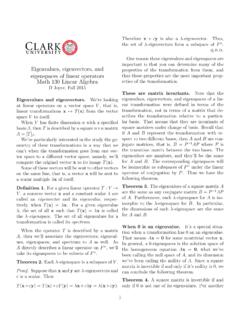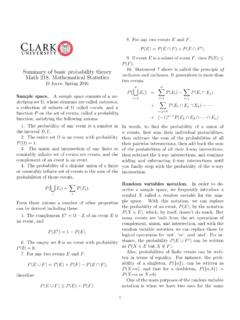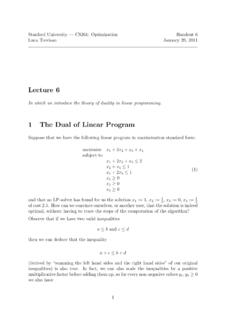Transcription of Covariance and Correlation Math 217 Probability and ...
1 Covariance and CorrelationMath 217 Probability and StatisticsProf. D. Joyce, Fall joint random vari-ables. TheircovarianceCov(X,Y) is defined byCov(X,Y) =E((X X)(Y Y)).Notice that the variance ofXis just the covarianceofXwith itselfVar(X) =E((X X)2) = Cov(X,X)Analogous to the identity for varianceVar(X) =E(X2) 2 Xthere is an identity for covarianceCov(X) =E(XY) X YHere s the proof:Cov(X,Y)=E((X X)(Y Y))=E(XY XY X Y+ X Y)=E(XY) XE(Y) E(X) Y+ X Y=E(XY) X YCovariance can be positive, zero, or indicates that there s an overall tendencythat when one variable increases, so doe the other,while negative indicates an overall tendency thatwhen one increases the other independent variables, then theircovariance is 0:Cov(X,Y) =E(XY) X Y=E(X)E(Y) X Y= 0 The converse, however, isnotalways (X,Y) can be 0 for variables that are not an example where the Covariance is 0 butXandYaren t independent, let there be threeoutcomes, ( 1,1), (0, 2), and (1,1), all with thesame probability13.
2 They re clearly not indepen-dent since the value ofXdetermines the value ofY. Note that X= 0 and Y= 0, soCov(X,Y) =E((X X)(Y Y))=E(XY)=13( 1) +130 +131 = 0We ve already seen that whenXandYare in-dependent, the variance of their sum is the sum oftheir variances. There s a general formula to dealwith their sum when they aren t independent. Acovariance term appears in that (X+Y) = Var(X) + Var(Y) + 2 Cov(X,Y)Here s the proofVar(X+Y)=E((X+Y)2) E(X+Y)2=E(X2+ 2XY+Y2) ( X+ Y)2=E(X2) + 2E(XY) +E(Y2) 2X 2 X Y 2Y=E(X2) 2X+ 2(E(XY) X Y)+E(Y2) 2Y= Var(X) + 2 Cov(X,Y) + Var(Y)Bilinearity of is linearin each coordinate. That means two things. First,you can pass constants through either coordinate:Cov(aX,Y) =aCov(X,Y) = Cov(X,aY).Second, it preserves sums in each coordinate:Cov(X1+X2,Y) = Cov(X1,Y) + Cov(X2,Y)andCov(X,Y1+Y2) = Cov(X,Y1) + Cov(X,Y2).
3 1 Here s a proof of the first equation in the firstcondition:Cov(aX,Y) =E((aX E(aX))(Y E(Y)))=E(a(X E(X))(Y E(Y)))=aE((X E(X))(Y E(Y)))=aCov(X,Y)The proof of the second condition is also XYof two jointvariablesXandYis a normalized version of theircovariance. It s defined by the equation XY=Cov(X,Y) X that independent variables have 0 correla-tion as well as 0 dividing by the product X Yof the stan-dard deviations, the Correlation becomes boundedbetween plus and minus 1. 1 XY are various ways you can prove that in-equality. Here s one. We ll start by proving0 Var(X X Y Y)= 2(1 XY).There are actually two equations there, and we canprove them at the same note the 0 parts follow from the factvariance is nonnegative. Next use the propertyproved above about the variance of a (X X Y Y)= Var(X X)+ Var( Y Y)+ 2 Cov(X X, Y Y)Now use the fact that Var(cX) =c2 Var(X) torewrite that as1 2 XVar(X) +1 2 YVar( Y) + 2 Cov(X X, Y Y)But Var(X) = 2 Xand Var( Y) = Var(Y) = 2Y,so that equals2 + 2 Cov(X X, Y Y)By the bilinearity of Covariance , that equals2 2 x YCov(X,Y) = 2 2 XY)and we ve shown that0 2(1 , divide by 2 move one term to the other sideof the inequality to get XY 1,so 1 XY exercise should remind you of the samekind of thing that goes on in linear algebra.
4 Infact, it is the same thing exactly. Take a set ofreal-valued random variables, not necessarily inde-pendent. Their linear combinations form a vectorspace. Their Covariance is the inner product (alsocalled the dot product or scalar product) of twovectors in that Y= Cov(X,Y)The norm X ofXis the square root of X 2defined by X 2=X X= Cov(X,X) =V(X) = 2 Xand, so, the angle betweenXandYis defined bycos =X Y X Y =Cov(X,Y) X Y= XYthat is, is the arccosine of the Correlation 217 Home Page ~djoyce/ma217/2















